- Job Seeker Statistics
- Career Change statistics
- Internship Statistics
- Job Search Statistics
- Average Number Of Jobs Applied
- Average Salary Increase When Changing Jobs
- Part Time Job Statistics
- Age Discrimination Statistics
- Networking Statistics
- Interview Statistics
- Average Number of Jobs In A Lifetime
- Teacher Statistics
- Resume Statistics
Research Summary. Changing jobs is becoming a popular move for plenty of American workers across the nation in search of a better fit. Meanwhile, the COVID-19 pandemic also caused a major uptick in individuals making career changes. After extensive research, our data analysis team concluded:
-
37% of the U.S. labor force changed or lost their job in 2020.
-
The average American worker has 12 jobs throughout a lifetime.
-
U.S. workers have an average tenure of about 4.1 years with a single employer.
-
65% of American workers are actively searching for a new full-time job right now.
For further analysis, we broke down the data in the following ways:
Demographics | Age | Reasons + Benefits | Trends
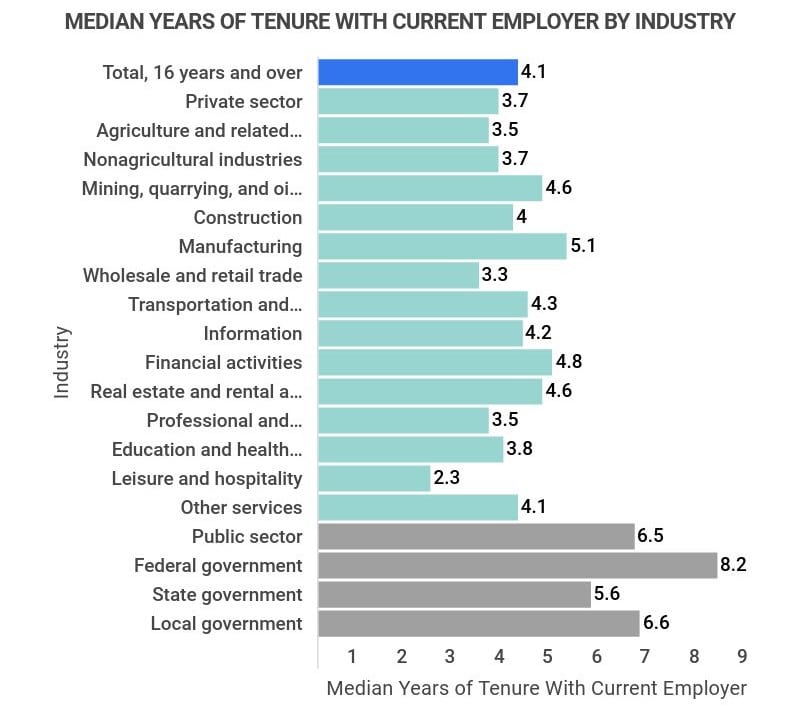
General Career Change Statistics
-
37% of the U.S. workforce changed or lost their job in 2020.
Due to the COVID-19 pandemic, more than one-third of U.S. workers either changed or lost their jobs in 2020—roughly double the typical amount recorded over the past two decades.
Of the 37% of American employees who had changed or lost their job in 2020, 26% had a different job, and 11% were unemployed.
-
The average person spends just shy of 100,000 hours at work throughout their lifetime.
The typical American employee will spend approximately 90,000 hours at work throughout their lifetime. That means people usually spend one-third of their lives working.
-
Middle-aged workers are the most likely group of people to make a major career change.
The average age that most employees make a major career change is 39 years old. Experts point to less financial risks and personal stresses as the main reasons 39-year-old workers seek such significant career shifts.
In addition to the average age of job hoppers, it’s also important to note that most people looking to switch careers are not in it for the money. In fact, 58% of people surveyed by Indeed said that they would be willing to take a pay cut to make a major career change.
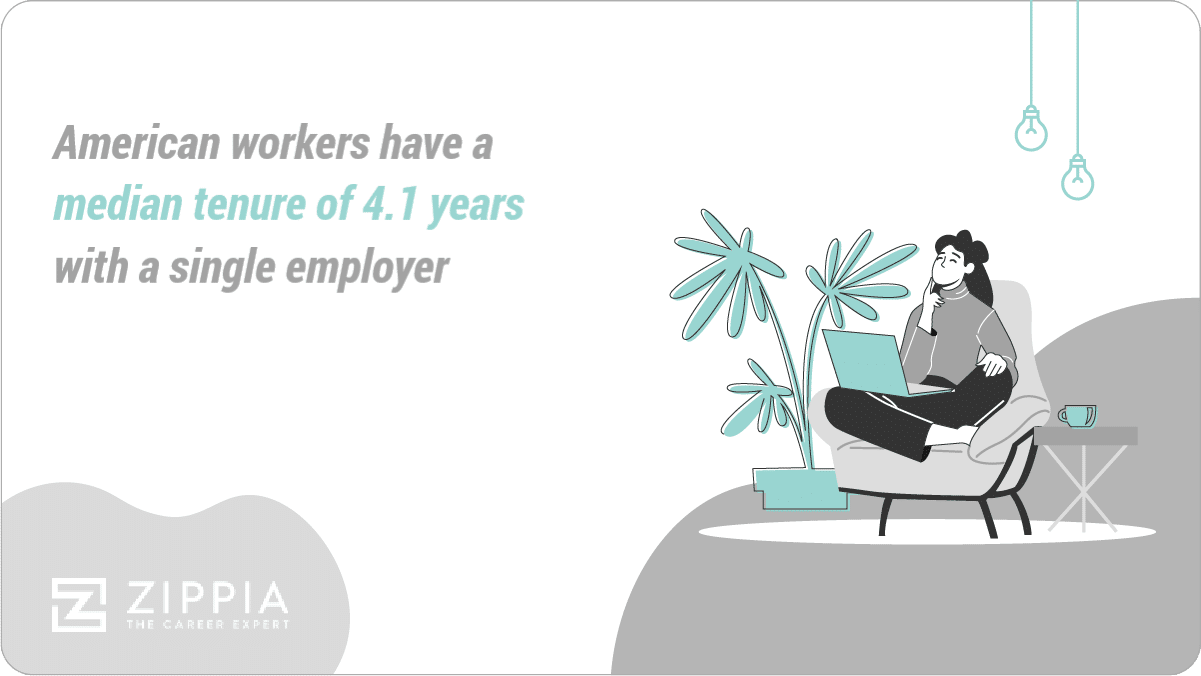
Career Change Statistics by Demographics
-
Men have a 10% longer average tenure with their employer than women.
In the United States, the average worker stays at their place of employment for roughly 4.1 years, according to January 2020 labor statistics. That number, however, varies based on gender. Research shows that women typically stay for 3.9 years while men usually keep a job for 4.3 years.
-
More white workers have been with their employer for at least a decade compared to Black, Hispanic and Asian workers.
Approximately 29% of White employees have been employed with their company for at least a decade, according to the U.S. Bureau of Labor Statistics. Average employee tenure rates, however, can vary significantly depending on race and ethnicity.
For instance, the same report found that 26% of Asians, 23% of Blacks, and 22% of Hispanics have been employed with their company for at least a decade. That means White workers are as much as 32% more likely to stay at a company for at least ten years compared to people of color.
-
Individuals working in the private sector tend to change careers more frequently than individuals working in the public sector.
Public sector employees had a median tenure of 6.5 years, while private-sector employees had a median tenure of just 3.7 years.
When it comes to government workers, federal employees had the highest meidan tenure (8.2 years), followed by state employees (5.6 years) and finally local government employees (6.6 years).
As for the private sector, manufacturing had the highest median tenure at 5.1 years, and the leisure and hospitality industry had the lowest, at just 2.3 years.
| Industry | Median Tenure (Years) |
|---|---|
| Total, 16 years and over | 4.1 |
| Private sector | 3.7 |
| Agriculture and related industries | 3.5 |
| Nonagricultural industries | 3.7 |
| Mining, quarrying, and oil and gas extraction | 4.6 |
| Construction | 4 |
| Manufacturing | 5.1 |
| Wholesale and retail trade | 3.3 |
| Transportation and utilities | 4.3 |
| Information | 4.2 |
| Financial activities | 4.8 |
| Real estate and rental and leasing | 4.6 |
| Professional and business services | 3.5 |
| Education and health services | 3.8 |
| Leisure and hospitality | 2.3 |
| Other services | 4.1 |
| Public sector | 6.5 |
| Federal government | 8.2 |
| State government | 5.6 |
| Local government | 6.6 |
Career Change Statistics by Age
-
Generally, younger and middle-aged people are more likely to change careers than older employees.
Since the COVID-19 pandemic began, roughly 22% of workers across the nation considered changing careers. When broken down by age, 30% of 18 to 39-year-olds considered switching jobs compared to only 12% of people aged 50 or older. Meanwhile, 21% of employees between 40 and 49 years old considered a career change.
That means approximately 1 in 3 U.S. workers under the age of 40 have thought about switching jobs since the start of the pandemic.
-
Younger Americans are more likely to consider moving, thus, more likely to consider a career change.
One of the primary reasons younger Americans change careers more frequently than older Americans is their increased desire to move to a new community, city, or state.
Roughly 41% of people between the ages of 18 and 39 have thought about moving during the COVID-19 pandemic, compared to just 24% of people between the ages of 40 and 64 and 11% of people aged 65 and over.
-
Employees under 24 years old have roughly 3.8 more job changes than workers over 45 years old.
In the United States, people between 18 and 24 have an average of 5.7 career changes. Meanwhile, people between 25 and 34 change jobs about 2.4 times, people between 35 and 44 years old switch occupations roughly 2.9 times, and individuals between 45 and 52 years old change jobs about 1.9 times.
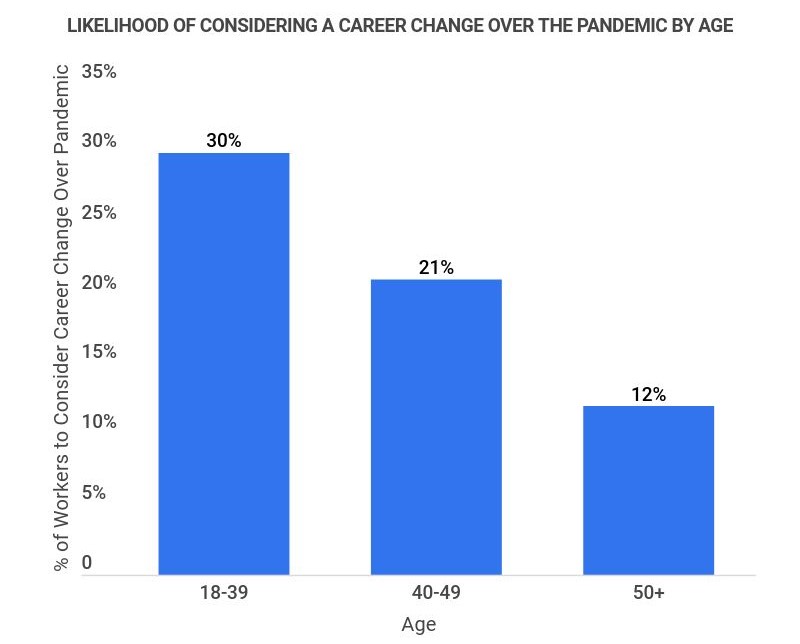
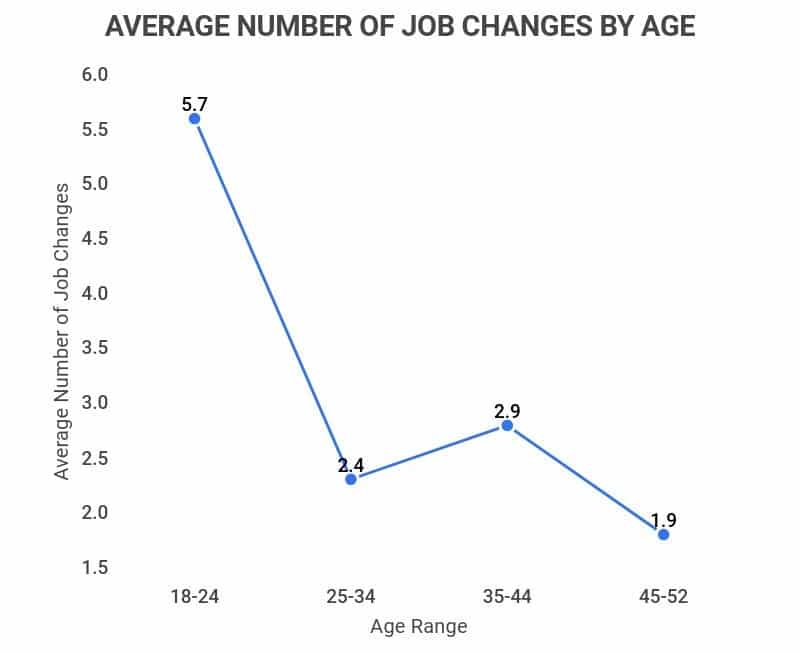
Reasons and Benefits: Career Change Statistics
-
Flexibility, financial incentives, and employee benefits are the top reasons people change jobs.
Negotiating a more lucrative salary, having more flexibility—including the ability to work remotely or on a hybrid schedule—and getting better benefits are, according to CNBC, the top reasons people change jobs and make major career shifts.
-
U.S. employees are more likely to change careers after celebrating a birthday or anniversary.
After celebrating a work anniversary, people tend to job hunt as much as 6% to 9% more than they otherwise would. Meanwhile, celebrating a birthday, especially a midlife milestone, makes people more likely to switch jobs, with job hunting jumping up 12%.
As illustrated by the statistics, times of self-reflection often prompt people to make a major career change.
-
Most people leave their job in search of more money.
It’s estimated that U.S. employees who stay at the same company for two years or longer earn about 50% less (or more) than employees who job hop.
Employees who leave their companies and get a new job in their field of expertise often receive a 20% to 50% pay increase. Meanwhile, employees who stay at their current job can expect a 1.3% to 4.5% pay raise each year.
-
Most employees view job-hopping as a strategic and beneficial career strategy.
As much as 64% of American Workers — and 75% of employees under the age of 34 — think that job-hopping is helpful to their long-term career success.
Career Change Trends and Projections
-
More than half of all U.S. workers considered making a career change at some point over 2020.
While 2020 shook up the employment market, many employees are still looking to make major changes this year. A whopping 52% of employed Americans are considering making a career change over 2020.
Data also revealed that 44% of American workers have concrete plans to change jobs.
The percentage of workers looking to make a career change is even higher for middle-income individuals whose annual household income lies between $50,000 and $75,000. As many as 59% of those individuals are considering a career switch.
-
About half of the U.S. workforce changes jobs every one to five years.
In 2018, 51% of American workers said they change jobs every one to five years. One year prior to that, in 2017, 42% of the labor force reported changing jobs every one to five years compared to just 34% in 2016.
-
Approximately 57% of surveyed employees said that their top barrier for making a career change is a lack of financial security.
Although more people than ever are making career changes, many Americans are still hesitant to switch jobs. Many U.S. workers point to money, uncertainty, and a lack of skills as the primary reasons they can’t make a major career change.
Meanwhile, 40% said they are unsure of what field to enter into next, and 37% said they didn’t have the proper education or experience to switch jobs. Age also posed a barrier for some, with 31% of individuals saying they thought they were too old to change careers.
-
Millennials and Gen Zs continue to be the age groups most likely to job hop.
In 2018, 6.5% of U.S. employees under 35 years old changed jobs compared to just 3.1% of workers aged 35 to 54.
Meanwhile, data collected earlier this year reveals that six in 10 millennials are open to job hunting. It’s estimated that of the one in five U.S. workers who switched jobs in the past year, 33% were GenZs and 25% were Millennials, according to a study conducted by IBM’s Institute for Business Value.
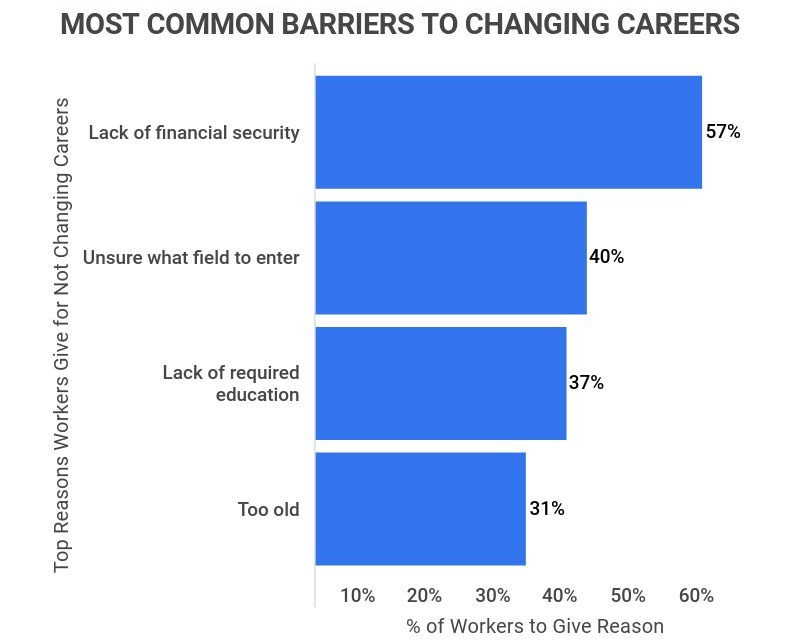
Career Change FAQ
-
How many times does the average person change careers?
The average American worker has 12 jobs throughout a lifetime. The average amount of times a person switches careers also varies by gender and age. For instance, the most popular age to make a major career change is 39.
In the United States, the average worker stays at their place of employment for roughly 4.1 years, according to January 2020 labor statistics. That number, however, varies based on gender. Research shows that women typically stay for 3.9 years while men usually keep a job for 4.3 years.
-
How often do successful people change jobs?
Successful people change jobs every three to five years. Across the United States, the average worker makes a career change every 4.1 years. However, there are no set guidelines for career-changing that will lead to the highest rates of success.
-
Is it good to switch jobs often?
Yes, it is good to switch jobs often. However, there is a fine line between furthering your career by switching jobs and hurting your career by job-hopping too frequently. When done correctly, switching jobs often helps to stimulate the American economy and usually increases a worker’s salary and employee benefits.
-
How do you know if you should change careers?
You know if you should change careers if you don’t enjoy your work, your workplace or coworkers negatively affect your mental health, and you’re not fairly compensated for the work that you do. Knowing that it’s time for a career change might not require all three, but usually, some combination of these factors means that it’s time for a switch.
When considering a career change, think about what aspects of your current job you do like — this will help you switch into a job that better suits not only your strengths, but also your interests.
-
What are the best jobs for a career change?
The best jobs for a career change depend on your professional history and skill set — generally speaking, you want to look for a job that matches your background and requires the use of the skills you most enjoy using.
For example, if you’re an accountant who finds that you actually enjoy the social and client-management aspects of your job more than the number-crunching, you might look for a job that emphasizes customer service, but still puts your accounting skills to good use.
Or if you’ve worked in food service for years and found you have a knack for finding and training good staff, you might be a natural fit for an HR role or something in recruiting. The point is, don’t look at your career history too much in terms of job titles, but rather skills and areas of interest.
Conclusion
Making a major career change is a huge professional and personal decision. While job-hopping was once viewed as a reg flag by hiring managers across the nation, it is now widely accepted as a beneficial way to stimulate the U.S. economy and find career growth.
For these reasons and more, an astonishing 65% of the U.S. workforce is actively searching for a new job at any given time.
Meanwhile, in 2020, the global pandemic resulted in an even bigger uptick in individuals changing their careers. Last year alone, roughly 37% of American workers changed or lost their jobs. In fact, the lingering effects of the pandemic are still resulting in more workers wanting to change jobs or make a major career shift.
With the average American employee holding 12 jobs throughout their lifetime—with an average tenure of about 4.1 years—it’s no surprise that job-hopping is on the rise.
References
-
Zippia. “Average Number Of Jobs In A Lifetime [2021]: All Statistics.” Accessed on October 27, 2021.
-
Fast Company. “Is Now A Good Time To Change Careers? More Workers Are Feeling Good About It.” Accessed on October 27, 2021.
-
Gettysburg College. “One Third Of Your Life Is Spent At Work.” Accessed on October 27, 2021.
-
CNBC. “Nearly Half Of Workers Have Made A Dramatic Career Switch, And This Is The Average Age They Do It.” Accessed on October 27, 2021.
-
Fortune. “A New Study Highlights That One In Three U.S. Workers Changed Or Lost Jobs In The Past Year.” Accessed on October 27, 2021.
-
The Washington Post. “Nearly A Third Of U.S. Workers Under 40 Considered Changing Careers During The Pandemic.” Accessed on October 27, 2021.
-
Indeed. “How Often Do People Change Careers?” Accessed on October 27, 2021.
-
Statista. “Individuals Changing Jobs Every One To Five Years In The U.S. 2016-2018.” Accessed on October 27, 2021.
-
Thomas Net. “Most Americans Desire A Career Change, But Face Key Barriers.” Accessed on October 27, 2021.
-
U.S. Bureau Of Labor Statistics. “Employee Tenure Summary.” Accessed on October 27, 2021.
-
CNBC. “Millennials, Gen Z Are Job Hopping, But Contrary To Popular Belief, Maybe Not Enough.” Accessed on October 31, 2021.
-
CNBC. “How Job Hopping In This Tight Labor Market Can Help You Snare A Fatter Paycheck.” Accessed on October 31, 2021.
-
Harvard Business Review. “Why People Quit Their Jobs.” Accessed on October 31, 2021.
-
Forbes. “Employees Who Stay In Companies Longer Than Two Years Get Paid 50% Less.” Accessed on October 31, 2021.
-
Harvard Business Review. “Why I Encourage My Best Employees To Consider Outside Job Offers.” Accessed on October 31, 2021.
- Job Seeker Statistics
- Career Change statistics
- Internship Statistics
- Job Search Statistics
- Average Number Of Jobs Applied
- Average Salary Increase When Changing Jobs
- Part Time Job Statistics
- Age Discrimination Statistics
- Networking Statistics
- Interview Statistics
- Average Number of Jobs In A Lifetime
- Teacher Statistics
- Resume Statistics




